Antioch School District congratulates the Class of 2024 graduates
Monday, June 3rd, 2024



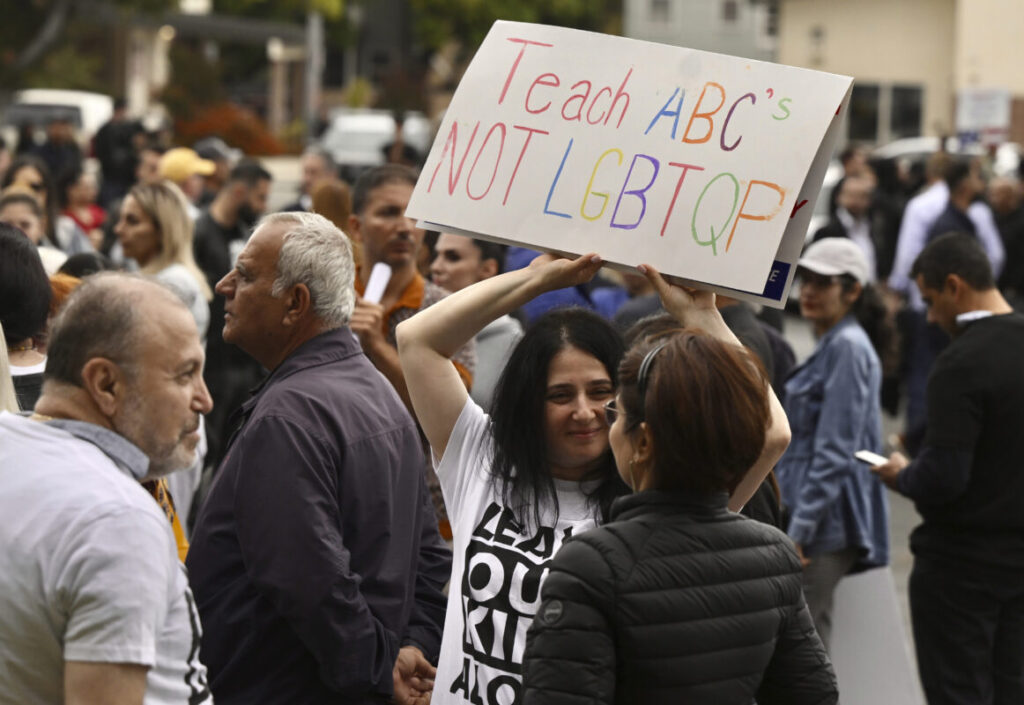
Protect Kids California’s effort would require schools to tell parents if their child signals gender changes, prevent biological males in girls’ sports and ban sterilization of children
Claim Attorney General’s ballot title and language change hurt signature gathering effort, lawsuit filed
“Our message is simple. Schools shouldn’t keep secrets from parents” – Protect Kids CA
By Allen D. Payton
California activists seeking to empower parents over their children’s decisions to identify as transgender failed to place a trifecta of restrictions on the November ballot known by the organizers as the Protect Kids of California Act of 2024. Attorney General Rob Bonta changed the ballot title to Restricts Rights of Transgender Youth. Initiative Statute and he changed the ballot language, as well which hampered the signature gathering efforts organizers claim.
According to Students First: Protect Kids California, the initiative will: (1) repeal the California law that permits students to compete in female’s sports and students to be in females’ locker rooms and bathrooms; (2) prohibit schools from deceiving parents about their student’s gender identity crisis and stop them from secretly transitioning a child; and (3) stop sex change operations and chemical castrations on minors.
The organization started late last fall to consolidate their three separate initiatives into one, and its signature-gathering efforts supported by 400,000 voters fell short of the 546,651 verifiable signatures that had to be collected within six months to make the presidential election ballot. The goal was to collect 800,000 signatures to be safe.
Organizers posted their complaint about Bonta’s ballot language changes on the group’s Facebook page on April 2. Initiative committee Executive Team member Nicole C Pearson wrote, “Every Californian, regardless of whether they agree with the initiative, should be concerned about an attorney general who ignores the law and uses his power to sabotage ballot initiatives. We plan to hold Bonta accountable for allowing his political agenda to get in the way of doing his job.”
The post included a link to an opinion on the Orange County Register website decrying the changes which reads, “As required by California law, proponents submitted the measure to Bonta to receive a neutral official title and summary to use in petitions. Bonta then returned the measure with a new title with a negative and misleading slant: the “Restricts Rights of Transgender Youth Initiative.” And he gave it a summary that was not only completely prejudicial and designed to mislead the electorate — it also contained lies.”
Then on Tuesday, May 28 the group issued a press release announcing the setback in a post on their Facebook page which reads, “We want to thank our tens of thousands of supporters and volunteers for this truly historic effort!Together, we collected over 400,000 signatures – an unprecedented achievement for a 100% grassroots effort. You really are amazing! While it is unfortunate we did not have enough signatures to make the 2024 ballot, we will build off this momentum to continue to fight for the principles set forth in the Protect Kids of California Act.”
The press release reads, “Protect Kids California announced on Tuesday, May 28, 2024, they collected an impressive 400,000 signatures for their proposed ballot measure but fell short of the 546,651 required to be collected within a 180-day timeframe to appear on the ballot.
Tens of thousands of volunteers gathered signatures from every county in California. The largest collection areas were Los Angeles, Orange, Riverside, San Bernardino, San Diego, Santa Clara and Alameda Counties.
A completely grassroots effort, Protect Kids California raised close to $200,000 from over 1,200 donors. This equates to less than 50 cents per signature, a fraction of the amount standard ballot measure committees spend.
“While we are disappointed we didn’t meet the threshold to qualify for the ballot, we are encouraged by the amount of support from every sector of the state. We gathered more signatures for a statewide initiative than any all-volunteer effort in the history of California.” “We had severe headwinds from the beginning. California Attorney General Rob Bonta issued a false and misleading Title & Summary for our initiative. That made our fundraising efforts more difficult. While we sued the Attorney General, a Superior Court Judge denied our motion in April. We plan to appeal the Superior Court Judge’s decision, at which time we will decide how to proceed in the future. If we had a little more time or a little more money, we would have easily qualified for the ballot.”
But battles over transgender issues will continue to burn bright in courts, school districts and the Legislature. Despite a setback, initiative organizers were buoyed by the 400,000 signatures that thousands of volunteers collected. They are confident that they will attract more donations and enough signatures to qualify for the November ballot two years from now — and find more support than leaders in heavily Democratic California assume exists.
“We’re very confident that voters would pass this if it gets to the ballot box,” said Jonathan Zachreson, a Roseville City school board member, co-founder of Protect Kids California and an official proponent of the initiative. “We gathered more signatures for a statewide initiative than any all-volunteer effort in the history of California.”
“We started around the holidays which didn’t help,” he added. “It was an all-volunteer effort. It usually takes about $7 million to get something on the ballot. We raised just under $200,000 which covered our costs. But we didn’t have money to pay signature-gatherers. We had around 25,000 to 30,000 volunteers. Our efforts really took off in the past two months. In the past few weeks, we were collecting so many signatures it was hard to keep up.”
The organizers proposed language for the three-pronged initiative read:
But Bonta’s ballot language for the initiative was changed to read instead:
The second issue has sparked a firestorm within the past year.
Last week, a Democratic legislator introduced a late-session bill that would preempt mandatory parental notification. Assembly Bill 1915, by Assemblymember Chris Ward, D-San Diego, would prohibit school districts from adopting a mandatory parental notification policy and bar them from punishing teachers who defy outing policies of LGBTQ+ students.
Last year, Assemblymember Bill Essayli, R-Corona, introduced a bill that would require parental notification, but AB 1314 died in the Assembly Education Committee without getting a hearing. Committee Chair Al Muratsuchi, D-Torrance, reasoned the bill would “potentially provide a forum for increasingly hateful rhetoric targeting LGBTQ youth.”
Ward cited surveys of transgender and gender nonconforming youths that found most felt unsafe or unsupported at home. In one national survey, 10% reported someone at home had been violent toward them because they were transgender, and 15% had run away or were kicked out of home because they were transgender.
The California Department of Education has issued guidance that warns that parental notification policies would violate students’ privacy rights and cites a California School Boards Association model policy that urges districts to protect students’ gender preferences.
But Zachreson argues that even if children have a right to gender privacy that excludes their parents, which he denies exists, students waive it through their actions. “At school, their teachers know about it, their peers and volunteers know about it, other kids’ parents know about it — and yet the child’s own parent doesn’t know that the school is actively participating in the social transition,” he said.
In some instances, he said, schools are actively taking steps to keep name changes and other forms of gender expression secret from the parents.
“What we’re saying is, no, you can’t do that. You have to involve the parents in those decisions,” he said.
Ward responds that many teachers don’t want to be coerced to interfere with students’ privacy and gender preferences. “Teachers have a job to do,” he said. “They are not the gender police.”
A half-dozen school districts with conservative boards, including Rocklin, Temecula Valley and Chino Valley, have adopted mandatory parental notification policies. Last fall, California Attorney General Rob Bonta sued Chino Valley, arguing its policy is discriminatory. A state Superior Court judge in San Bernardino agreed that it violated the federal equal protection clause and granted a preliminary injunction. The case is on appeal.
Last July, U.S. District Court judge for Eastern California threw out a parent’s lawsuit against Chico Unified for its policy prohibiting disclosure of a student’s transgender status to their parent without the student’s explicit consent. The court ruled that it was appropriate for the district to allow students to disclose their gender identity to their parents “on their own terms.” Bonta and attorney generals from 15 states filed briefs supporting Chico Unified; the case, too, is on appeal.
While some teachers vow to sue if required to out transgender students to their parents, a federal judge in Southern California sided with two teachers who sued Escondido Union School District for violating their religious beliefs by requiring them to withhold information to parents about the gender transition of children. The judge issued a preliminary injunction against the district and then ordered the return of the suspended teachers to the classroom.
No California appellate court has issued a ruling on parent notification, and it will probably take the U.S. Supreme Court for a definitive decision. Essayli pledged to take a case there.
The National Picture
Seven states, all in the deeply red Midwest and South, have laws requiring identification of transgender students to their parents, while five, including Florida and Arizona, don’t require it but encourage districts to adopt ther own version., according to the Movement Advancement Project or MAP, an independent nonprofit.
Two dozen states, including Florida, Texas, and many Southern and Midwest states ban best-practice health care, medication and surgical care for transgender youth, and six states, including Florida, make it a felony to provide surgical care for transgender care. Proponents cite the decision in March by the English public health system to prohibit youths under 16 from beginning a medical gender transition to bolster the case for tighter restrictions in the United States.
California has taken the opposite position; it is one of 15 like-minded states and the District of Columbia with shield laws to protect access to transgender health care. They include New York, Oregon, Washington, Colorado and Massachusetts.
Twenty-five states have laws or regulations banning the participation of 13- to 17-year-old transgender youth in participating in sports consistent with their gender identification.
Not one solidly blue state is among those that have adopted the restrictions that Protect Kids California is calling for. But Zachreson and co-founder Erin Friday insist that contrary to the strong opposition in the Legislature, California voters would be open to their proposals. They point to favorable results in a survey of 1,000 California likely voters by the Republican-leaning, conservative pollster Spry Strategies last November.
The voters surveyed were geographically representative and reflective of party affiliation, but not demographically, The respondents were mostly white and over 60, and, in a progressive state, were divided roughly evenly among conservatives, moderates and liberals.
Two Versions of Protecting Children
Both sides in this divisive cultural issue say they’re motivated to protect children. One side says it’s protecting transgender children to live as they are, without bias and prejudice that contribute to despair and suicidal thoughts. The other side says it’s protecting kids from coercion to explore who they aren’t, from gender confusion, and exposure to values at odds with their family’s.
Zachreson and Friday wanted to title their initiative “Protect Kids of California Act of 2024.” But Bonta, whose office reviews initiatives’ titles and summaries, chose instead “Restrict Rights of Transgender Youth. Initiative Statute.” Zachreson and Friday, an attorney, appealed the decision, but a Superior Court Judge in Sacramento upheld Bonta’s wording, which he said was accurate, not misleading or prejudicial.
“The ballot title was obviously biased and the summary was intentionally meant to deceive voters and hampered our efforts to get this on the ballot this year,” Zachreson continued. “The statutory requirement is to be impartial and factual. He did the opposite. He was biased and he had descriptions that were false. Bonta claimed there were no exceptions for student safety when notifying parents. But that’s not correct. It’s already in the law.”
Zachreson is appealing again. A more objective title and summary would make a huge difference, he said, by attracting financial backing to hire signature collectors and the support and resources of the California Republican Party, which declined to endorse the initiative. That was a strategic mistake in an election year when turnout will be critical.
“The people who support the initiative are passionate about it,” he said.
The organizers may have to start over but a lawsuit about the biased title and summary was filed asking for a change in the language, to use the signatures already gathered and to grant an extension.
“The appeal won’t be heard until after the November election,” Zachreson shared.
Effort for November 2026 Ballot Continues
If a judge rules in their favor it will make it easier for the group to complete the signature gathering to qualify for the next General Election ballot which will be in November 2026.
Political observer Dan Schnur, who teaches political communications at USC, UC Berkeley and Pepperdine University, agreed that the gender debate could have motivated Republicans and swing voters to go to the polls.
“There’s no question that the Attorney General’s ballot language had a devastating effect on the initiative’s supporters and it could have almost as much of an impact on Republican congressional candidates this fall,” he said.
“Our message is simple. Schools shouldn’t keep secrets from parents; we should protect girls’ sports and private spaces at school; and we should protect kids from unproven, life-altering and often sterilizing medical procedures. We vow to continue fighting for these principles,” the group’s May 28th press release concluded.
To learn more about Protect Kids California, visit http://www.protectkidsca.com.
John Fensterwald who writes about education policy and its impact in California for EdSource.org contributed to this report.
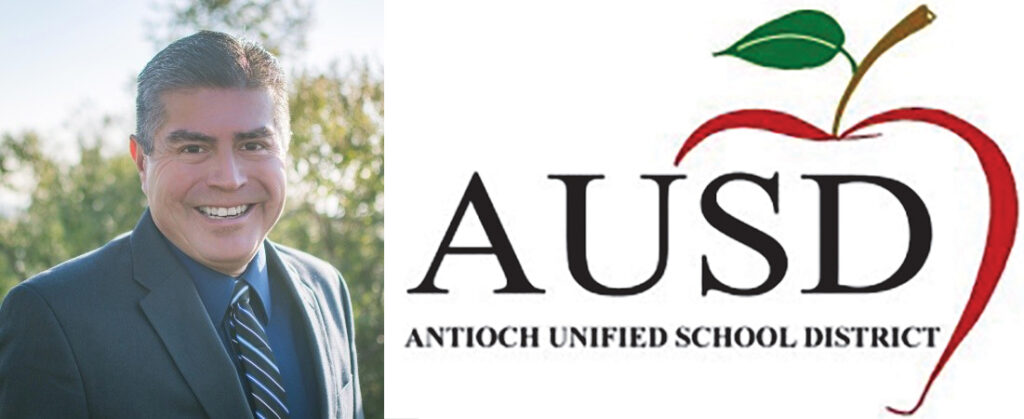
While Anello out on medical leave; oversaw internal investigations of bullying complaints
By Allen D. Payton
The Antioch School Board appointed the school district’s Chief Human Resources Officer, Certificated HR, Dr. Robert Martinez as acting superintendent, Wednesday night, May 22, 2024, to serve while Superintendent Stephanie Anello is out on medical leave.
Following their closed session meeting, which also included a performance evaluation of Anello, Antioch School Board President Antonio Hernandez announced, “The Board has selected Dr. Robert Martinez as acting superintendent on a 3-2 vote.”
However, Anello was not in attendance and Hernandez did not mention anything about that agenda item.
Martinez, who goes by Rob, oversaw the recent internal investigations of the complaints against Kenny Turnage by district maintenance employees. The results of the investigations have not been satisfactory to those employees, nor Hernandez who has publicly called for Anello’s resignation in spite of not having provided her with an annual evaluation for at least two years. Two additional investigations of the complaints using outside individuals are underway. Plus, Hernandez has called for a separate, board-led “investigation on the policies, practices, and culture of the Antioch Unified School District that impact our employees and students.” (See related article)
At the beginning of the Superintendent’s Report agenda item of the meeting, Martinez said, “First off, let me just say thank you to the board for the trust that you’ve placed in me to serve as the acting superintendent.in Superintendent Anello’s absence,” Martinez. “I will hold that responsibility with great care, compassion and commitment for all of our students, staff, families and community.”
About Dr. Rob Martinez
According to his LinkedIn profile, “Dr. Robert A. Martinez is currently the Chief of Human Resources for the Antioch Unified School District (in which he has served since June 2022). He previously served as Superintendent/CEO of Griffin Technology Academies, and the Mt. Diablo Unified School District. He was the Assistant Superintendent in the Fairfield-Suisun Communities where he worked for 32 years. Dr. Martinez has continually focused on improving and expanding educational opportunities for students. He strives to advance understanding of resiliency research for all his employees, students, and their families. He seeks to support all District personnel with advancing their personal and professional skills, knowledge, and expertise in working with children as unique individuals with unlimited capacities. He has served as a Board Member of the Association of California School Administrators (ACSA), ACSA President-Elect of for Region 4, Past-President of Solano ACSA Charter, as a Board Member for the California Association of Latino Superintendents and Administrators (#CALSA/Greater San Francisco, Bay Area, Region 1) and is currently the Vice President of Legislative Action for ACSA Region 4. He was awarded ACSA’s most acclaimed Personnel/Human Resources recognition in 2019. Dr. Martinez holds a B.A. in Psychology and an M.A. in Education, both from the University of California, Davis. He is extremely proud to have earned his Educational Doctorate Degree in Educational Leadership and Management with a concentration in Human Resources, from Drexel University.
His new book, “Recipes for Resilience, Nurturing Perseverance in Students and Educators” was recently released and is available on @Amazon. He shares messages from his life and lessons learned. His life’s work has focused on helping others live courageous, resilient lives. He previously authored “The Story of Sparkle and Shine,” a story of positivity and action for good.
He is available to provide keynotes, consultation, and training on building resilient cultures that create powerful safe places for our children and adults to learn, grow and develop in peace. He believes building resilience in each person, in equitable safe places is of paramount importance.
You can follow him @ResiliencyGuy @Twitter, @Instagram, @Facebook @Youtube.
Educator, Superintendent, Past CALSA Board of Director, Past ACSA Board Member, ACSA Region 4 Board Member, Solano ACSA, Life-long Learner, Dr. Rob often says, “Let the lives we help others live be the measure of our success.”
Martinez earned his Master of Arts Degree in Education in 1992 from U.C. Davis and his Doctorate of Education Educational Leadership, Human Resources Concentration from Drexel University in 2013.

Two investigated, two more under investigation
Calls out school board president’s claims complaints were mishandled although board hadn’t heard about response by HR Dept until May 8
Superintendent not involved, still on medical leave; board must choose acting supe
CSEA questioned on claims of vote of no-confidence in AUSD cabinet
By Allen D. Payton
In an email to Antioch Unified School District staff on Wednesday, May 15, 2024, the District’s Chief Human Resources Officer, Dr. Robert A. Martinez informing them of the “recent media coverage regarding certain personnel matters within our organization” and “to provide clarity and address some of the concerns that may have arisen as a result.” He was referring to the claims by some district employees by Kenny Turnage, the Director of Maintenance and Operations, including placing a desk on the roof of a district building and the display of a sign pointing up to it that it’s the location of an employee’s desk. Turnage was recently placed on administrative leave pending the completion of the investigations.
In response to the matter, AUSD Board President and Area 1 Trustee Antonio Hernandez called for Superintendent Stephanie Anello’s resignation claiming she and the District had mishandled the investigation, amid complaints her husband and Turnage are close friends. Hernandez also held a Closed Session at the beginning of the regular board meeting last Wednesday, May 8 in which a vote to terminate her contract failed two-to-three.
The board president also attempted to evaluate Anello, but she did not attend the closed session or regular meeting, as she was out on medical leave. (See related articles here, here and here)
Martinez went on to write his May 15th letter, “First and foremost, I want to assure you that the District takes all employee matters seriously and handles them with the utmost care and diligence. Any complaints or issues brought forward are thoroughly investigated by our Human Resources Department or a third party, independent firm, in accordance with established protocols, procedures, board policy, and applicable law.
“Two of the four complaints recently highlighted in the media coverage, were in fact processed consistent with the District’s practices, protocols, procedures, board policy, and applicable law in that they were investigated by Human Resources and the complainants were responded to with the Confidential Administrative Determination letters that contained findings. In addition, under the Superintendent’s (Stephanie Anello’s) direction they were subsequently reviewed by an outside, third-party, independent investigator which found that the internal investigations and appeal processes were appropriately conducted, finding no irregularities in the investigation processes or the findings of the investigations. The two more recent complaints are under investigation and will go through a similar process. If and when there is a need for employee discipline, based on the evidence and findings, such discipline would be assigned by the Human Resources Department, again based on appropriate protocols, board policy, collective bargaining agreements, and applicable law.”
Calls Out Board President Antonio Hernandez for Falsely Claiming Process Was Mishandled
Martinez’ letter continued with, “Last month, the Board President spoke to the media claiming the District mishandled certain employee complaints. However, it was not until last Wednesday, May 8th, that the Board first heard about the steps the Human Resources Department took to investigate and respond to the complaints. Moreover, the District and subsequently the Board has also been informed by an outside, third-party, independent investigator who reviewed the District’s handling of the complaints, that the District acted appropriately and in accordance with the law.
It is important to understand that personnel matters are confidential in nature, and as such, we are limited in the information that we can disclose publicly. While we understand that this may lead to speculation or misinformation, we want to emphasize that the District remains committed to protecting the privacy rights of employees while being transparent where possible.
We also want to make it clear that Superintendent Anello was not directly involved in the investigation, findings, or disciplinary actions related to these matters. This is consistent with the District’s practices, policies and procedures.
“We understand that media coverage can be unsettling, especially when it involves our organization. However, we encourage you to focus on the important work that we do every day to support our students and the community.”
Martinez then offered some encouraging words about Measure B and other district matters.
He concluded his letter with, “Superintendent Anello is currently on medical leave and looks forward to returning once her doctor releases her to return. The Governing Board is working to identify an acting superintendent in her absence. More information will be shared once that person has been determined by Board action.” (See AUSD May 15, 2024 letter)
April 24 District Press Release
Previously, Martinez announced the two initial investigations in a press release issued on April 24, 2024, which was only sent to media who requested information. It wasn’t received by the Herald until May 8, although information about the matter was requested of District personnel on Saturday, April 27th.
In that press release he wrote, “We wish to provide an update with regard to recent developments within the Antioch school district that garnered public attention.
“To ensure transparency and accountability within our district, two separate investigations have been initiated to look into concerns raised publicly by an individual board member. The first investigation will review the overall situation, providing a comprehensive understanding of the circumstances involved. The second investigation will specifically address the two recent complaints that have been filed against an employee within the district.
“Furthermore, in the interest of maintaining the integrity of the investigative process and obviate any concerns, Superintendent Anello has voluntarily removed herself from direct involvement. Moving forward, I will be assuming responsibility for overseeing the investigations and working with the Board of Education regarding this situation.
Upon completion, the Board of Education will receive results of the investigations and will address any issues that may arise with the utmost diligence and transparency. It is important to understand that individual board members do not have authority to take action and provide direction, board authority rests with the majority of the body. To this point, decisions regarding the District, including decisions about leadership, must be made collectively by the Board as a whole.
“While this situation is understandably causing concern and questions, I am confident that the remarkable professionals in our schools and across our organization will continue to keep the wellbeing of our students as a top priority.” (See AUSD April 24, 2024 media release)
April 19 Antioch CSEA Chapter 85 Press Release, President Claims Vote of No-Confidence in AUSD Cabinet That May Not Have Occurrred
Earlier, on April 19, the California School Employees Association (CSEA) local Antioch Chapter 85 issued a press release – which was also not sent to the Herald but received this past Monday, May 13 – about the bullying claims and Board President Antonio Hernandez’ unilateral call for Anello’s resignation.
The press release read, “CSEA chapter 85 is aware of the allegations of bullying and harassment against employees, we are working with our members to ensure their rights aren’t being violated. We do not condone any bullying or harassment of any employee or students. We stand by our members and appreciate everything they do daily for the students and the community. We encourage the school board to thoroughly investigate all the allegations and stand up for what’s right, as is their role as elected officials. CSEA Chapter 85 – Antioch.” (See CSEA April 19, 2024 media release)
In addition, as previously reported, the chapter president, Brian Atkinson, announced at the May 8 school board meeting that the executive committee held a vote of no-confidence in the superintendent. However, whether that vote ever occurred has come into question.
The chapter was sent an email on Wednesday, May 15, 2024, asking when that vote occurred, for the names of the executive board members, how many members were in attendance, for the actual motion, and the vote count, plus, a copy of the minutes of the executive board meeting during which the vote was taken.
According to the Chapter 85 website, there are eight members of their executive committee, including Atkinson, 1st VP Linda Rambeau-Jaime, 2nd VP Luis Sandoval, Chapter Secretary Anna Hernandez-Guzman, Chapter Treasurer Lilian Morataya, Communications Officer Joan Burke, Site Rep Coordinator Laura Dickerson and Sergeant at Arms Michael Brisco. The website’s Contacts page also lists Chief Steward Marcos Valdez and Stewards Erik Pitschner, Levon Edwards and Thomas Sellers.
In addition, both Board President Hernandez and CSEA Chapter 85 were emailed asking for a response to today’s letter from Dr. Martinez.
No responses were received prior to publication time.
Please check back later for any updates to this report.
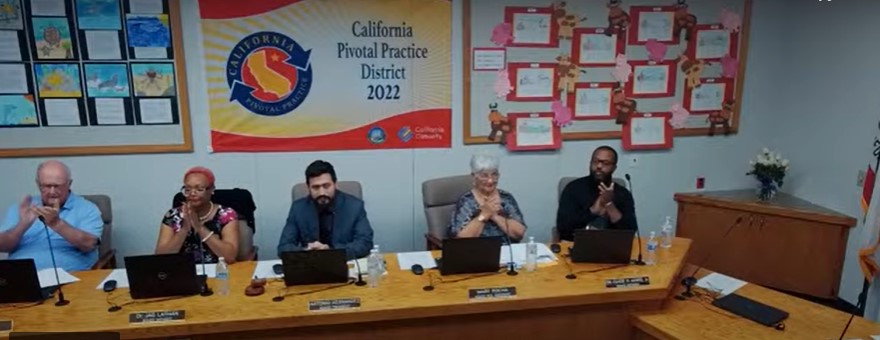
Before evaluating Anello; with her absence Board President Hernandez again unable to conduct her evaluation
By Allen D. Payton
During a closed session meeting on Wednesday, May 8, 2024, the Antioch Unified School District (AUSD) Board was anything but unified as a vote to terminate Superintendent Stephanie Anello’s contract failed two-three. While how each trustee voted was not reported out by Board President Antonio Hernandez, it can safely be assumed he was joined by Trustee Jag Lathan in supporting the motion and it was opposed by Trustees Mary Rocha, Gary Hack and Dr. Clyde Lewis, Jr.
It was Hernandez’s third attempt in three weeks to hold the closed session board meeting to discipline, dismiss or release Anello followed by her performance evaluation. The superintendent was still out on sick leave, for a total of two weeks as of today, foiling his efforts for the latter agenda item. (See related articles here and here)
The closed-door meeting, which is required for personnel matters, began at 6:00 p.m. and was attended by all five board members, following one public comment by Kim Atkinson, a Purchasing Technician for the school district. She is the wife of union leader Brian Atkinson, president of the Antioch Chapter 85 of the California Schools Employee Association. He also holds the position of Assistant Regional Representative for the statewide union.
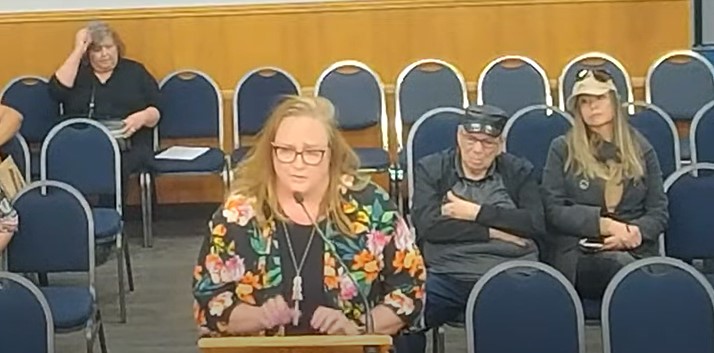
“Who is running our district, right now?” she asked. “We are in crisis without a leader. Kenny Turnage was at a school district golf tournament, last Friday. Is this how the district handles administrative leaves? Do we need to have the state step in?”
“Liz (Robbins – the District’s Chief Business Official) brought Kenny Turnage to the office. I was terrified,” Atkinson continued. “On the video you can see he walked out with files. What files does he need when he’s on administrative leave?”
However, it was the annual Antioch Rotary Golf Tournament that Turnage attended at the Lone Tree Golf Course.
Following the closed session, which lasted about 50 minutes, the board held a special Recognitions session that was to begin at 6:45 p.m. but started late.
District Teachers, Classified Representatives of the Year Honored
Before the regular meeting began, AUSD Teacher of the Year Nicole Vicknair of Bidwell Continuation High School and runner up Samantha Marquardt of Marsh Elementary were honored by Associate Superintendent of Educational Services Christine Ibarra. (See related article) Vicknair is also one of the finalists for the Contra Costa County Teacher of the Year, which will be determined later this year.
In addition, Danielle French was honored as the 2024 Classified Representative of the Year, as well as finalists, Lisa Bagwell and Jezebel “Jijie” Siao.
The meeting took a brief break for photos of the award winners and board members, as well as refreshments.
Hernandez Announces Failed Closed Session Vote to Terminate Anello
At 7:15 p.m., Hernandez called the meeting back to order and reported out of closed session. He said, “A motion and second to terminate the superintendent’s contract were made. The vote was two-three, and the motion did not pass. However, Hernandez did not say how each individual board member voted.
During public comments by district staff, Brian Atkinson spoke saying, “The executive board of our chapter took a vote of no-confidence for the cabinet.”
He then mentioned “the desk on the roof”, which is one of the complaints against Turnage. “They called it a joke. Two people thought it was funny. That’s in the paperwork” referring to the findings from one of two district investigations into the matter.
His wife Kim then spoke again repeating much of what she had said earlier.
That was followed by shouts from those in attendance of, “What do we want? Justice. When do we want it? Now,” which weren’t gaveled down by Hernandez.
Rocha Warns of Impact on Bonds from District Turmoil
Toward the end of the meeting, under Agenda Item 22 entitled Rocha read from prepared remarks warning of the impact on the bond ratings from the current district turmoil. She said, “I’d like to make my own statement, explain and clear some facts. I’m just making a statement.”
“As to the special board meetings, from one day to the next I was told to come to a meeting. It was my birthday weekend. I was not contacted by the board chair and I’m the co-chair,” Rocha added.
Lewis said, “I do want to clarify, I found out about the first board meeting, I wasn’t available for both of those meetings. I found out the day of. I think the way it’s painted in the media I refused. No. I found out the day of.”
UPDATE: In a post on his Facebook page, Thursday morning, Lewis offered additional information about the special meetings. He wrote, “I want to thank everyone who reached out to check on me since last night, you are truly appreciated.
Just for clarity, there were questions about why I was not in attendance for the unilaterally called special board meetings. In both instances, I was informed of the meeting the day of the meeting was set to occur. Professional courtesy and collaborative leadership would (or should at least) dictate that scheduling a meeting should begin with identifying availability.
I’m not saying these decisions are politically motivated or informed, but I’m not, not saying that either.”
#keepitabuck #politicalpressurerevealed
Video of the meeting can be viewed on the District’s YouTube channel.
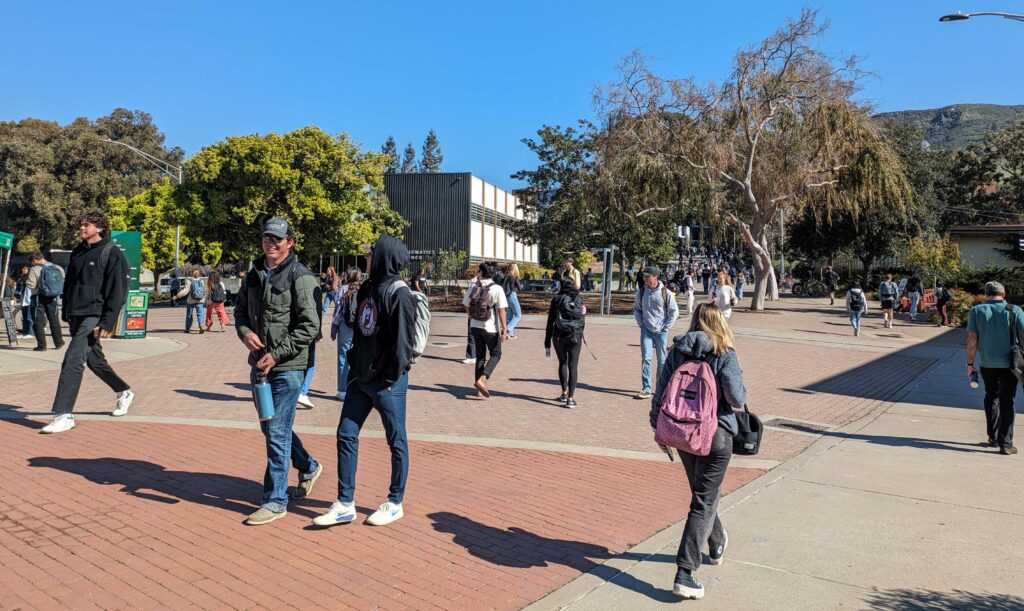
Some have been exempt from paying out-of-state tuition since 2001
By Zaidee Stavely, EdSource – Republished with permission
More than 20 years ago, California passed a law allowing some undocumented immigrant students to attend college with in-state tuition, if they meet certain requirements.
But immigrant rights advocates say many students who should have been eligible have been wrongfully denied in-state tuition because of confusion over requirements, misinformation and different interpretations of the law at different college campuses.
“We lose that incredible brain power and colleges are losing enrollment,” said Nancy Jodaitis, director of higher education for Immigrants Rising, a nonprofit organization that advocates for undocumented people to achieve educational and career goals.
Immigrants Rising brought together officials from all three public college systems — California Community Colleges, California State University and University of California — to discuss and agree on answers to frequently-asked questions about the law.
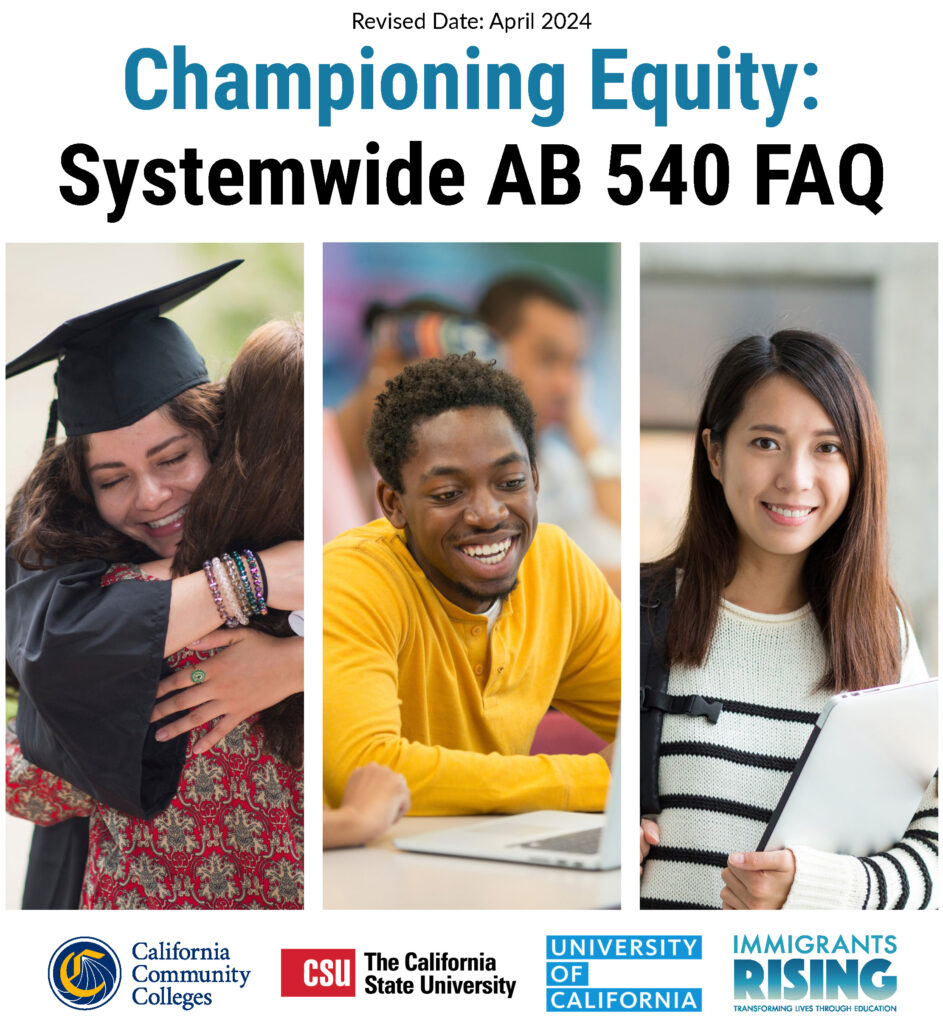
The result is a document called the Systemwide AB 540 FAQ, which all three systems have now signed. The document includes answers to 59 questions, such as:
Spokespeople from UC, CSU and California Community Colleges all celebrated the document.
Paul Feist, vice chancellor of communications and marketing for the California Community Colleges Chancellor’s Office, said the document is particularly important because there are several different laws regarding the nonresident tuition exemption.
The first bill exempting some undocumented immigrants from out-of-state tuition, Assembly Bill 540, was signed into law in 2001. Since then, three other bills have been passed to expand the law, in 2014, 2017 and 2022.
“While the intent was to expand access to AB 540 financial assistance, they had the unintended effect of making it more difficult to navigate,” Feist said. “This FAQ is designed to provide clearer explanations and provide additional resources in advising students.”
Under current California law, students who are undocumented or have temporary protection from deportation such as Deferred Action for Childhood Arrivals (DACA), or who are U.S. citizens or permanent residents, are eligible for in-state tuition and state financial aid, if they attended at least three years of high school, adult school or community college in California and obtained a high school diploma or equivalent, an associate degree or fulfilled the minimum requirements to transfer to a UC or CSU.
Access to state financial aid and in-state tuition can be a critical factor for undocumented students, who are barred from receiving federal financial aid. Without the law in place, some of them would be charged tuition rates for international students, often much higher than in-state tuition.
“This is huge,” said Maria Gutierrez, a college counselor at Chabot College in Hayward and a doctoral student at San Francisco State University. “It helps us be aligned and have something in writing.” Before the FAQ document, Gutierrez says college staff in charge of approving exemptions from out-of-state tuition were sometimes afraid to make decisions without written proof of how to interpret the law.
Gutierrez herself has benefited from AB 540. She came to the U.S. when she was 5 years old on a visa, which later expired. She attended elementary, middle and most of high school in California. She also graduated from high school in California. But when she applied to attend community college in California, different campuses disagreed on whether she was eligible for in-state tuition because she had spent two years of high school in Utah. At the time, a second law had recently been passed to allow colleges to consider years of attendance in elementary and middle school for AB 540 eligibility.
“One college that I went to in So Cal, I was approved for AB 540. When I had to go back to the Bay Area, I was not approved for AB 540. So then I was confused that there was this inconsistency,” Gutierrez said.
A few years later, when she applied to transfer to a four-year college, both UC and CSU campuses told her she was not eligible for in-state tuition, even though by then, a law had passed that clarified that attendance at community college could be counted toward the requirements. She spent a semester paying out-of-state tuition at San Jose State University, before the university finally acknowledged she was legally eligible for in-state tuition.
As a college counselor, Gutierrez continues to meet students who have been incorrectly told they are not eligible for in-state tuition.
“It’s crazy because in reality it hasn’t changed much,” she said. However, she said, the financial burden is harder now, because most students graduating from high school cannot apply for work permits under DACA, because the government has not accepted new applications since 2017.
“I see my students now and I see the struggles they’re going through. If I didn’t have DACA, I honestly don’t think I would be where I am now,” Gutierrez said. “There’s no way that I would’ve been able to pay nonresident fees or wait for whoever it is that is determining that to learn what they need to do for me to be able to go to college.”
Advocates say they hope the document will help colleges give correct information and avoid students having to research on their own for information.
California also recently streamlined the process for undocumented students to apply for financial aid and exemption from in-state tuition on the same application when they fill out the California Dream Act application. In the past, students had to both fill out a California Dream Act application and an AB 540 affidavit form for each college. Now, the AB 540 form will be part of the same application.
Diana Aguilar-Cruz said that change is significant. Aguilar-Cruz is currently pursuing a master’s degree in public health at Cal State Fullerton. When she first began her undergraduate education at Cal Poly Pomona, she was charged nonresident tuition, which was almost double the in-state tuition. She had immigrated to the U.S. from Mexico City in 2015, when she was 14 years old, and lived with her grandmother in Baldwin Park while attending high school.
She had completed a California Dream Act application, but no one told her she also had to complete a separate form. After researching it herself online, she found the form and completed it, at which point the university finally changed her tuition to in-state.
“If I didn’t find it in my Google search, would I be paying in-state tuition for my four years of college?” Aguilar-Cruz said. “I always think to myself, what would have happened if I was a more fearful student or a student who did not have a strong support system at home?”
According to the Renewing the Dream page on the California Student Aid Commission’s website, “In 2021-22, only 29% to 30% of undocumented college students who applied for financial aid through the California Dream Act Application (CADAA) ultimately enrolled in school. Moreover, only 14% of California’s estimated undocumented student population in postsecondary education ultimately received state financial aid.”
Allen D Payton contributed to this report.
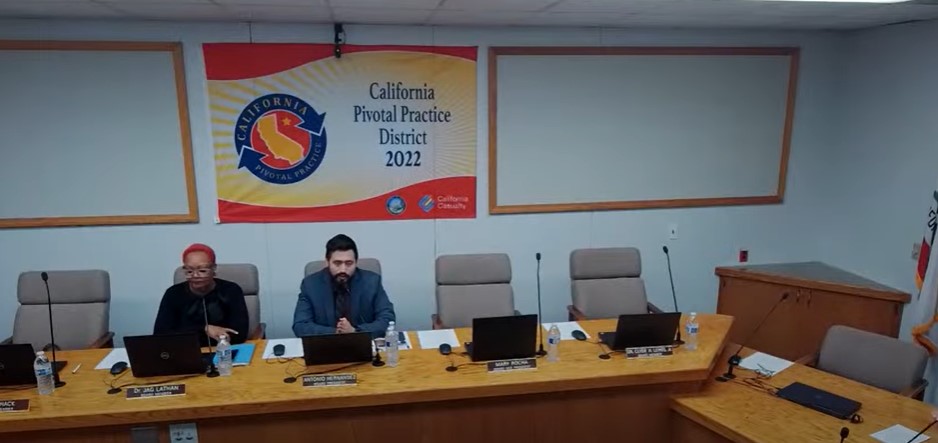
Following no quorums for special board meetings on the matter
Questions go unanswered by Hernandez about his efforts and by district staff on complaints against Turnage, two possible investigations
By Allen D. Payton
Only two Antioch Unified School District (AUSD) Board members attended the second special meeting called by Board President Antonio Hernandez for Thursday, April 25, 2024. That prevented the closed session from being held to consider the discipline, dismissal or removal of Superintendent Stephanie Anello and her evaluation. The meeting lasted less than a minute. (See the 8:00 minute mark of the board meeting video) (See related article)
As a result, he has included the same two items for the Closed Session portion of the regular board meeting scheduled for next Wednesday, May 8. The agenda items are listed as, 2.B. Public Employee: Discipline/Dismissal/Release [Pursuant to Government Code § 54957] and 2.C. Public Employee Performance Evaluation Title: Superintendent [Pursuant to Government Code section 54957].
The meetings follow his complaints about how Anello has handled the response to employee complaints against Kenny Turnage, who, at least until recently, was Director of the District’s Facilities, Maintenance and Operations Department. It is a repeated attempt by Hernandez, who has recently, publicly called for Anello’s resignation, to oust her since his second month in office following the November 2020 election. (See related article)
April 25 Board Meeting Cancelled
Hernandez, with Area 2 Trustee Jag Lathan sitting at the dais to his right, called the meeting to order at 7:05 p.m. Vice President Mary Rocha, and Trustees Dr. Clyde Lewis and Gary Hack were not in attendance and Anello’s seat was also empty. As previously reported, both Rocha and Lewis said they were unable to attend the meeting, were not asked if they could, and learned of it the day before. Nor did Rocha participate in setting the agenda, although the normal practice of the board is to include the vice president. In addition, Rocha shared that Anello had informed the trustees on Wednesday before the special meeting was called that she would be on sick leave until Tuesday, April 30. As of that day, Anello had still not returned to work.
During the April 25th meeting, a district staff member called the roll then said, “President Hernandez, we do not have a quorum. As you mentioned, the Brown Act (state open meeting law) prevents us from conducting a meeting.” Hernandez repeated what she said for those in the audience saying, “So, because we have not reached a quorum we cannot conduct official business. So, next I will entertain a motion to adjourn, as that is allowed under meetings.” While he was saying that last sentence the video switched to show just the district’s logo and then, as Lathan was making a motion, saying, “I make a motion,” the video ended before completing what she was saying.
On the Board Meeting page of the District’s website, it shows the first special meeting doesn’t appear and the second shows as, “CANCELLED”.
Attempts to reach Hack before the meeting asking if he planned to attend and attempts, following the meeting, asking him why he didn’t attend were unsuccessful.
More Questions for Hernandez Go Unanswered
In addition to the questions asked of Hernandez the night before the meeting, which have so far gone unanswered, the following were sent to him after: “Have you received any legal or other advice on how to handle the two items on your special meeting agenda? If so, from whom did you seek it? Since there was no quorum for either special meeting will you now place those two items on the agenda for the next regular school board meeting scheduled for May 8 and hold a closed session prior to its start at 7:00 p.m.?”
He did not respond. However, the last question was answered when the May 8th board meeting agenda was released on Friday.
Anello has not had an evaluation since at least January 2021 as the board has not been able to agree on the goals the members want her to achieve, upon which her evaluation could be based.
Some of the previous questions asked of Hernandez included, “Upon what do you plan to base the board’s evaluation of the superintendent? Have you and the board set any goals for the superintendent to achieve? Do you think it’s appropriate to call for the superintendent’s resignation before evaluating her performance? How can you fairly evaluate a superintendent after you’ve publicly called for their resignation?” Again, he has not yet responded.
Questions for District Staff Also Go Unanswered, Public Records Act Request Submitted
Questions were also emailed to Anello and other AUSD staff members, copying Kenny Turnage, sent on Saturday, May 27, have also gone unanswered.
They were asked if an internal investigation had already been conducted, by whom, and if it was someone in the District’s Human Resources Department and possibly Senior Director of Certificated HR Carrie Wells. They were also asked for the findings and if it was determined the desk Turnage moved to the top of a district maintenance department building was an extra desk from storage, not the employee’s and that Turnage did it as a joke.
The district staff members then were asked if any of that information was incorrect to provide the correct information.
They were also asked if the investigation, reported by NBC Bay Area, will be handled internally or by an outside agency or individual.
The district staff was also asked if what Trustee Rocha had shared, and was reported in a previous Herald article, that as of Wednesday morning April 24, Anello was on sick leave and that the board was informed prior to the special meeting being called for Thursday, April 25 is correct.
Finally, they were asked if Turnage was still working at his desk in the maintenance department office until Friday, April 19 and then placed on paid administrative leave as of Monday, April 22, as shared with the Herald by a district employee. Finally, the district staff members were asked where Turnage is currently working in the district, for his title, responsibilities and if any other district employees answer to him.
They were given until last Monday at noon to respond. Since they failed to, the questions were then submitted as a Public Records Act (PRA) request, for which government agencies have up to 10 business days to respond. The response can also be extended an additional 14 days if necessary. (See “The People’s Business – A Guide to the California’s Public Record Act” by the League of California Cities)
May 8 Board Meeting
Next Wednesday’s meeting will be held in the Board Room in the District Offices at 510 G Street, in historic, downtown Rivertown. The Closed Session begins at 6:00 p.m. with public comments allowed prior, recognitions and the regular meeting will begin at 7:00 p.m. It can also be viewed live on the District’s YouTube channel.
Please check back for any updates to this report.
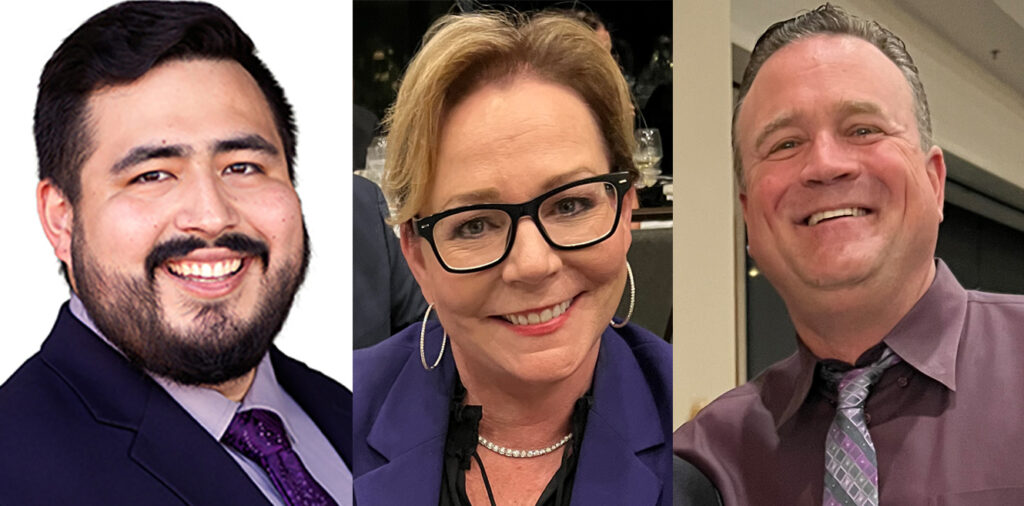
Following employee complaints of a supervisor for prank that occurred over a year ago
Second special meeting in a week scheduled unilaterally by Hernandez – who has publicly called for Anello’s resignation – without confirming if other board members can attend; at least two trustees can’t
By Allen D. Payton
Following Antioch Unified School District employee complaints of their former boss of placing an employees’ desk on the roof in January 2023 and bullying them, and several news reports by NBC Bay Area, Superintendent Stephanie Anello has come under fire from Board President and Area 1 Trustee Antonio Hernandez. Both he and Area 2 Trustee Jag Lathan have been quoted in one or more of the news reports commenting on the employee matter. Now, Hernandez is calling for Anello’s resignation because of the incident. (See related articles here, here and here)
While the Director of Facilities, Maintenance and Operations, Kenny Turnage, II, pulled the prank and, in response, Anello has moved him into the district office to oversee the funds from the recently passed Measure B bond measure.
Before taking his position with the school district, Turnage owned and operated K2GC in Antioch which was voted repeatedly as the city’s best General Contractor over multiple years. While Chair of the Antioch Planning Commission in 2020, he was removed by a vote of the Antioch City Council following comments about COVID on his personal Facebook page. That effort was led by District 4 Councilwoman Monica Wilson who Turnage was expected to run against later that year. He was honored as the 2015 Antioch Citizen of the Year for Most Impact. Instead of running for city council Turnage run unsuccessfully in 2020 for AUSD Area 3 Trustee.
Turnage is good friends with Anello’s husband, former Antioch Police Chief Allan Cantando, which has caused some to complain and speculate the AUSD employee is being given special treatment by the superintendent.
Now, according to another NBC Bay Area news report, based on leaked information not provided to board members in an email but not to other media by the superintendent nor district staff, Anello has called for a separate investigation of the matter without her involved.
Yet, Hernandez has called two special board meetings, with a second one scheduled for Thursday, April 25, 2024 at 7:00 p.m., to Public Employee Discipline/Dismissal/Release [Pursuant to Government Code section 54957] and Public Employee Performance Evaluation Title: Superintendent [Pursuant to Government Code section 54957 and at least two other board members can’t attend. He called the first special meeting for last Friday, but it could not be held for lack of a quorum.
According to Area 3 Trustee Dr. Clyde Lewis who said he can’t attend this week’s special meeting, explained that the school board meeting agendas are set by the president, vice president and superintendent. But Vice President and Area 5 Trustee Mary Rocha was not involved.
When asked to verify that, Rocha said, “I have not been included in any of Antonio’s dealings. He said Thursday he was holding a special meeting on Friday and instructed a staff member to call the other board members. But I was going out of town for my birthday weekend. No meeting was held due to a lack of quorum. So he called another one for this Thursday and I didn’t know about it until school board staff called me and I didn’t know what was on the agenda. I’d only heard it was similar to the one before.”
“I have a funeral to attend tomorrow and family visiting from Texas, and I don’t see the urgency,” she explained. “Stephanie gave notice early Wednesday morning that she’s out on sick leave until Tuesday.”
“But when you’re the board president, out of courtesy, why would you call a special meeting if you didn’t know if your members can attend?” Rocha asked. “He’s talking to the TV and throwing us under the bus trying to claim we don’t care and he’s the only one who does.”
“Now, it’s getting hot with the employees complaining about Kenny Turnage,” she continued. “It’s a personnel matter. Stephanie has to tell us what they’re doing with it. We’ve had people come to the board meetings and complain and it’s been referred to her to handle it. But I have an email from her that she’s calling for a separate investigation without her involved,” confirming that Anello sent her email to board members.
“A separate personnel commission was set up in the 1970’s to protect from nepotism,” Rocha explained. “If we create a new position, their job is to set up job description and wages. There has always been a maintenance director, but the previous person retired and Turnage applied for it. We don’t know who else applied for it. After the person goes through the interviews and then they’re brought to us for approval. We found out who it was, afterwards.”
“You call a special meeting to deal with an employee evaluation and discipline and possible removal when they’ve done something like embezzlement,” the Area 5 Trustee stated. “Every board president is responsible for the annual evaluation. But none of them have scheduled one for the superintendent since, I think the last one by Diane Gibson-Gray. Clyde tried to have one last year. But every year we can’t seem to agree on the right trainer to help us in the evaluation process and set our goals.”
“This is all coming in from the mayor,” Rocha stated. “He and Antonio are best buddies. Then you have Jag. Just go look at all the photos with the mayor. They’re the only two invited. Antonio is always announcing events the mayor invites him to, ribbon cuttings and grand openings. But we’re never invited.”
Asked if this is another attempt by the board minority to terminate Anello, Rocha said, “heck, yes. They tried it with Ellie when she was president.”
That effort was also supported by Hernandez, but Lewis, Rocha and Area 4 Trustee Gary Hack wouldn’t support it.
“They tried it when Debra Vinson was one of two members on the board giving her problems,” Rocha added.
“You can’t evaluate her when you don’t have any goals,” she continued. “That situation with Turnage was a year ago. all of a sudden, they’re bringing it up. But the superintendent did something to handle it. She moved him out of the position and put him in the district office to deal with the bond issue. But we haven’t had much communication with her about it.”
“You have to give employees the opportunity to clean things up. You can’t just fire them. They have rights,” Rocha explained.
“Antonio isn’t giving us the courtesy, he’s just talking to the reporters,” she complained. “The president is just out there condemning the employee. What right does he have to do that?”
“When that reporter showed up at the council meeting with the cameras rolling, the president should have cut the mic,” Rocha stated. “He should have told the reporter, we can’t discuss that, it’s a personnel matter. But he allowed the press to speak against both of them, Stephanie and Turnage. The president kept allowing it to happen.” (See April 10, 2024 Antioch School Board meeting video at the 1:10:17 mark)
Questions were sent to Hernandez late Wednesday night asking why he is scheduling special board meetings before first having district staff poll the members to ensure there will be a quorum as didn’t happen for last Friday’s special meeting that he called. The board president was also asked, “Why are you setting the agenda unilaterally without discussion and confirmation with the board vice president as is the practice? Upon what do you plan to base the board’s evaluation of the superintendent? Have you and the board set any goals for the superintendent to achieve?”
Hernandez was also asked, “Is this another attempt to terminate Ms. Anello like you and then-Board President Ellie Householder unsuccessfully attempted following your election in 2020? Are you the one who leaked the information about the superintendent’s call for a separate investigation? Are you aware Ms. Anello has called in sick through next Tuesday as of Wednesday morning so she won’t be able to attend the closed session for the board to evaluate her? Do you think it’s appropriate to call for the superintendent’s resignation before evaluating her performance? Do you think it’s appropriate for a school board member to publicly speak about a personnel matter and about specific employees? How can you fairly evaluate a superintendent after you’ve publicly called for their resignation?”
Attempts to reach both Turnage and Anello about the employee complaints and the response by the superintendent have been unsuccessful to date.
AUSD board meetings are held in the Board Room at the District Office, located at 510 G Street in historic, downtown Rivertown. Thursday’s special meeting, if held, can be viewed live on the District’s YouTube channel.
Please check back later for his responses and any other updates to this report.